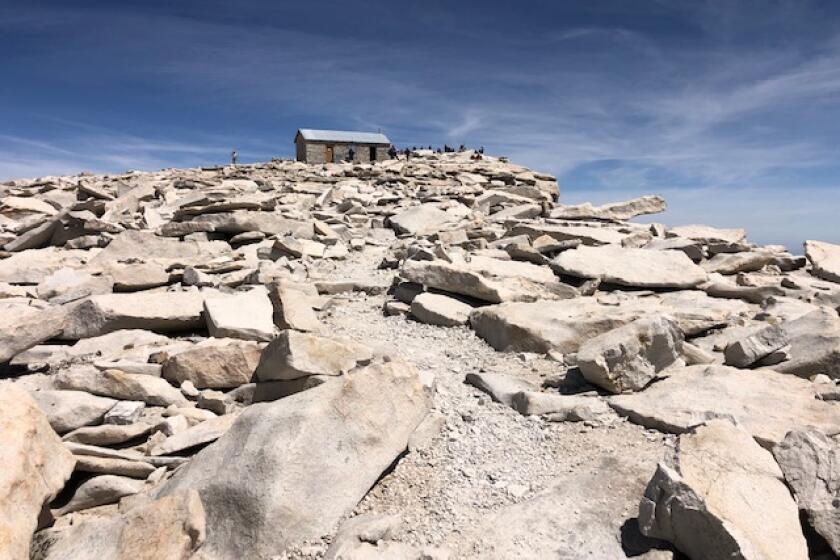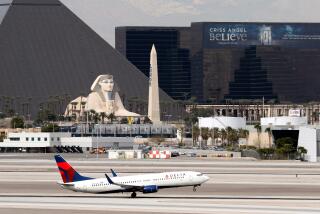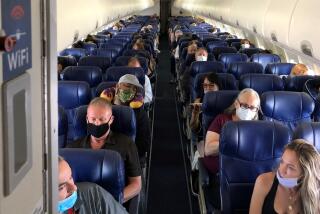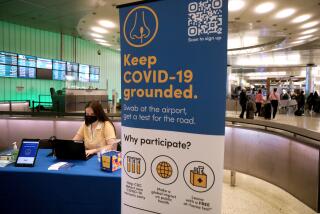With new safety measures in place, an anxious flight attendant takes wing again
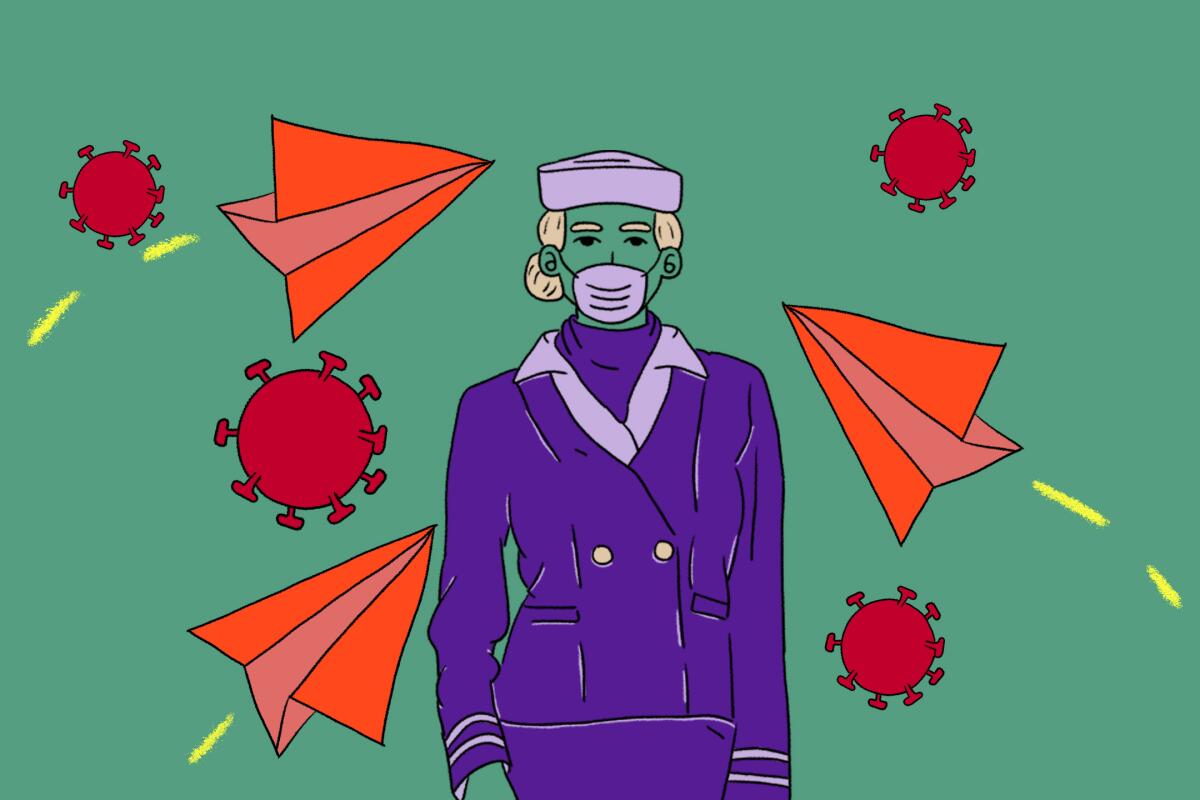
- Share via
Because of an unpaid leave of absence, an 80% reduction in my airline’s flight schedule, and my reluctance to draw a breath within the confines of an airplane cabin where a single symptomless traveler might transmit the coronavirus, I had been grounded from my flight attendant job since March 25.
Back then, the airline I work for had yet to implement safety protocols to help prevent the spread of COVID-19.
Face masks or coverings were not yet mandatory for passengers and crew. Pilots and flight attendants were not subjected to temperature scans before working a flight.
Customer service agents had not been instructed to assign middle seats as a last resort. A drawer stocked with personal protective equipment (face masks, extra latex gloves, hand-sanitizing gels and wipes) had not been provisioned on a single flight.
Two-person jump seats were still occupied by two flight attendants, their bodies wedged together without armrests to provide even a modicum of social distance.
Inyo National Forest awaits word from health and law enforcement officials before letting hikers up the 14,000-foot peak of Mt. Whitney.
But by May 22, the date of my first flight from Miami International Airport in nearly two months, the aforementioned safety protocols were firmly in place. That includes a provision that bypasses Federal Aviation Administration regulations and temporarily allows a specified flight attendant to sit alone — for taxi, takeoff and landing — in a designated passenger seat instead of with a colleague in the two-person jump seat.
Besides these airline-mandated safety measures, I’ve added a few of my own. I bought and carry with me at all times extra face masks, latex gloves and hand sanitizer. I wash my hands constantly and refrain from touching my face.
So when I donned my uniform and hopped in my car for the 40-minute commute to Miami International, I felt perfectly prepared to fly again.
Then bad luck reached out and slapped me. As I cruised Interstate 95, my left-rear tire exploded. I steered the wobbling vehicle into the breakdown lane and sat for a moment as the stench of burning rubber filled my nostrils.
I got out of the car and surveyed the damage. The shredded tire clung to the rim by a few rubber strands.
There, beneath a blazing South Florida sun, I rushed to change the tire in time to make my flight. The temperature had climbed to well above 90 degrees. Humidity hovered near 80%. Sheets of sweat dripped from my face, and my uniform shirt was drenched with perspiration.
I mention the blown tire, intense heat and heavy sweating only because I worried it would preclude my ability to pass the newly implemented crew temperature scan at the airport.
Las Vegas, the largest hotel city in the U.S., recycles soaps for countries that need it. And now, the U.S. is one of them
When I showed up hot and sweaty at the Known Crewmember security checkpoint, I stopped in my tracks. Any crew member registering a temperature of 100.4 or higher would automatically receive a re-test. If the second test registered 100.4 or higher, a third test would be administered after a 15-minute wait. If the temperature continued to register 100.4 or higher, the crew member would not be permitted to report for duty.
Would my overheated frenzy be mistaken for a fever?
I ducked out of the KCM queue and into a nearby men’s room to splash cool water on my face. I still felt hot. Beads of sweat formed on my bald head and dripped down my face. But the clock was ticking. Only a few minutes before I would be late for sign-in.
I wiped my face and returned to the checkpoint.
A mask-wearing, glove-clad flight service manager aimed the no-contact digital thermometer through a baseball-size cutout in a sheet of protective Plexiglas. She motioned for me to position my forehead on my side of the cutout. I held my breath, knowing that an abnormal temperature reading would mean the loss of a two-day trip worth $700.
After triggering the temperature scan, the agent looked at the LED readout and shouted, “98.4,” approving my passage into the secure area.
The normally bustling Concourse D was all but deserted, save a few airport employees and a smattering of passengers who wandered past shuttered shops on the way to the four or five gates (out of a possible 60) from which flights were departing.
My flight to Dallas was uneventful, almost eerily so. As mandated by the airline, everyone wore masks. No one rang their flight attendant call button. Few passengers spoke. The same could be said of my three strangely quiet colleagues.
Perhaps conversation was stifled because face masks muffle our voices, making words difficult to hear above the roar of aircraft engines. Or perhaps we’d all been muted by a sense of trepidation.
Because snack and beverage services have been eliminated on most flights, the major interaction between passengers and crew came during the boarding process. As customers stepped onto the aircraft, we handed out snack bags containing bottled water and a granola bar.
Compared with my Miami-San Juan, Puerto Rico, flight on March 25, when only 14 passengers boarded, this flight from Dallas to Miami two months later carried 130 customers on the same Boeing 737 configured with 172 seats.
Perhaps enhanced safety measures, small though they may be, are giving more of us the confidence to fly again.
More to Read
Sign up for The Wild
We’ll help you find the best places to hike, bike and run, as well as the perfect silent spots for meditation and yoga.
You may occasionally receive promotional content from the Los Angeles Times.
